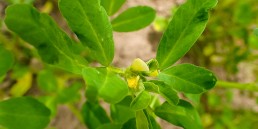What is a “herbal action”?
When we speak about the action(s) of a certain plant, we are referring to one or more effects a plant can have on our body. Often these actions are explained in two or three words; however, herbal actions are so much more than that! Since plants are wonderful complex beings, they also have several actions. Most herbs can compliment their action(s) in combination with another herb, basically showing off their best side with the support of a “good friend”. Sometimes they work great on their own, but most of the times, they excel with a good buddy on their side. Think- Teamwork!
Demulcents
Let’s have a talk about our “Gentle Healers”. Not only are demulcent herbs soothing and gentle, but they also tend to be very nutritive. They are gently supporting and helping us to heal. A group of herbs you simply have to love…
Demulcent herbs are rich in carbohydrate mucilage, which is composed of heteropolysaccharides (various forms of sugars). These posses the ability to bind themselves to water, which will then turn viscous/gel like and stick to the surface of the plant material. Have you ever made yourself a pot of chia pudding? You may have noticed how the dried seeds swell up after a few minutes of being exposed to water (both warm or cold). They can build what seems like a soft cocoon of viscous mucilage around them. A leaf of common mallow will also easily demonstrate this effect – notice how after a few times chewing your saliva turns viscous and gel-like?
Did you know that some plants like to use this feature of the mucilaginous, “slimy cocoon” to spread their seeds? When ingested by animals, the protective coat often helps prevent the eaten seeds from being digested. You can guess what happens next… The animals defecate the coated seeds and give them a little boost with their very own fertilizer. Fascinating!!
Generally Speaking, Demulcents are Indicated in:
- Dry, tight tissues
- Inflammation with dried out mucous secretion
- To cool, coat and soothe
- To stimulate peristalsis in constipation
- As binder in cases of diarrhea
- Soothe stomach and esophageal tissue from acid burn
- Prevent ulceration
- Irritations in the urinary tract
- As lubrication and skin emollient
The energetics of demulcents are fairly straight forward; they are generally moist and tend to be cooling. Due to the polysaccharides, they tend to have a sweet taste. We also have to remember that the energetics of a herbal action are more of a guideline. Considering the individual herb to more properly “classify” its energetics is the right path to go.
Examples of Some Demulcent Plants
Demulcents for the digestive tract:
Althea officinalis (Marshmallow), Plantago scarba (Psyllium husk) or Linium usitatissimum (Flax seeds). Demulcent herbs have to ability to lay a protective coat over mucous membranes and other tissue it comes in contact with. Therefore, demulcents used in the digestive tract have the ideal conditions to show of their best side.
Demulcents for the respiratory tract:
Verbascum Thapsus (Mullein), Tussilago farfara (Coltsfoot), Althea officinalis (Marshmallow). By providing a protective coat over the inflamed airways, demulcents soothe and function as analgesics, anti-inflammatory and as protective layer over the mucous membranes.
Emollient herbs for the skin:
Linium usitatissimum (Flax seeds), Symphytum officinale (Comfrey), Althea officinalis (Marshmallow). Many herbalists refer to mucilage internally used as demulcents and topically used as emollients. Emollients help provide flexibility to dry, irritated and inflamed skin conditions. Often times, applying the herb in form of a poultice seems to work very effectively.
Demulcents for irritation in the urinary tract:
Elymus repens (Couch grass), Zea mays (Conrsilk) and Althea officinalis (Marshmallow) are all excellent demulcents for any irritation, burning, and other irritable sensations in the urinary tract and have been used very successfully over many generations. Diuretics working on solid material work best with the assistance of lubricating demulcents.
Preparing a Cup of Tea
Traditionally, most demulcents are prepared via cold infusions. The reason behind this is that we are focusing to mainly extract the mucilaginous polysaccharides – our gentle healers… If you are preparing milder or more complex demulcents, you might be looking at a hot infusion.
A very effective way is to infuse 1-2 tbsp of dried herb into 1 liter of cold water. Let this sit overnight. In the morning, you have a wonderful soothing infusion. You could also just let it sit for a few hours, but the longer the herb infuses, the more viscous the tea will get.
Especially on hot and dry days, you might want to consider adding some Althea officinalis root to your water; it will help you stay better hydrated and tastes super yummy!
I hope this post gave you a little insight on demulcent herbs and how they can interact with our body. This topic is covered much more in depth in the herbal course, which is currently developed and coming soon by our group of wonderful herbalists.

Comfrey Leaf (Symphytum officinale)
Resources:
Besides my own words and oral teachings from many wonderful herbalists, this write up features’ information from the following resources:
Ursel Buehring Praxis- Lehrbuch Heilpflanzenkunde – Grundlagen – Anwendung – Therapie. 4 ueberarbeitete Auflage. Karl F. Haug Verlag in MVS Medizinverlage Stuttgart GmbH & Co. KG’ 70469 Stuttgart, Germany. 2014. (Published in German language)
Jim McDonald – Foundational Herbcraft – www.herbcradft.org – collected writings from www.PlantHealkerMagazine.com.
David Hoffmann – Medicinal Herbalism: The science and practice of herbal medicine. Healing Art Press, Rochester, Vermont 05767. 2003.
Abrah Arneson – The Herbal Apprentice: Plant Medicine and the Human Being – Green Heart Press. 2014.
Matthew Wood – The practice of Traditional Western Herbalism – Basic Doctrine, Energetics and Classification – North Atlantic Books, Berkley, California. 2004.
Rosemary Gladstar –Rosemary Gladstar’s Herbal Recipes For Vibrant Health: 175 Teas,…- Storey Publishing, LLC – September 3, 2008
Evelyn Mueller
I am a community herbalist based in Ontario, Canada, and a graduate of The Ginkgo Tree Herbal Course and founder and creator of ‘The Lion’s Tooth’: a 12 month program to help families re-connect with nature and use plants like their ancestors did. It is my mission to share the wonders nature provides for us, to establish meaningful relationships between humans and plants as well as to help awaken our embedded instincts and use those to nurture and heal our body, our mind and our wonderful earth.
Subscribe to Blog via Email



